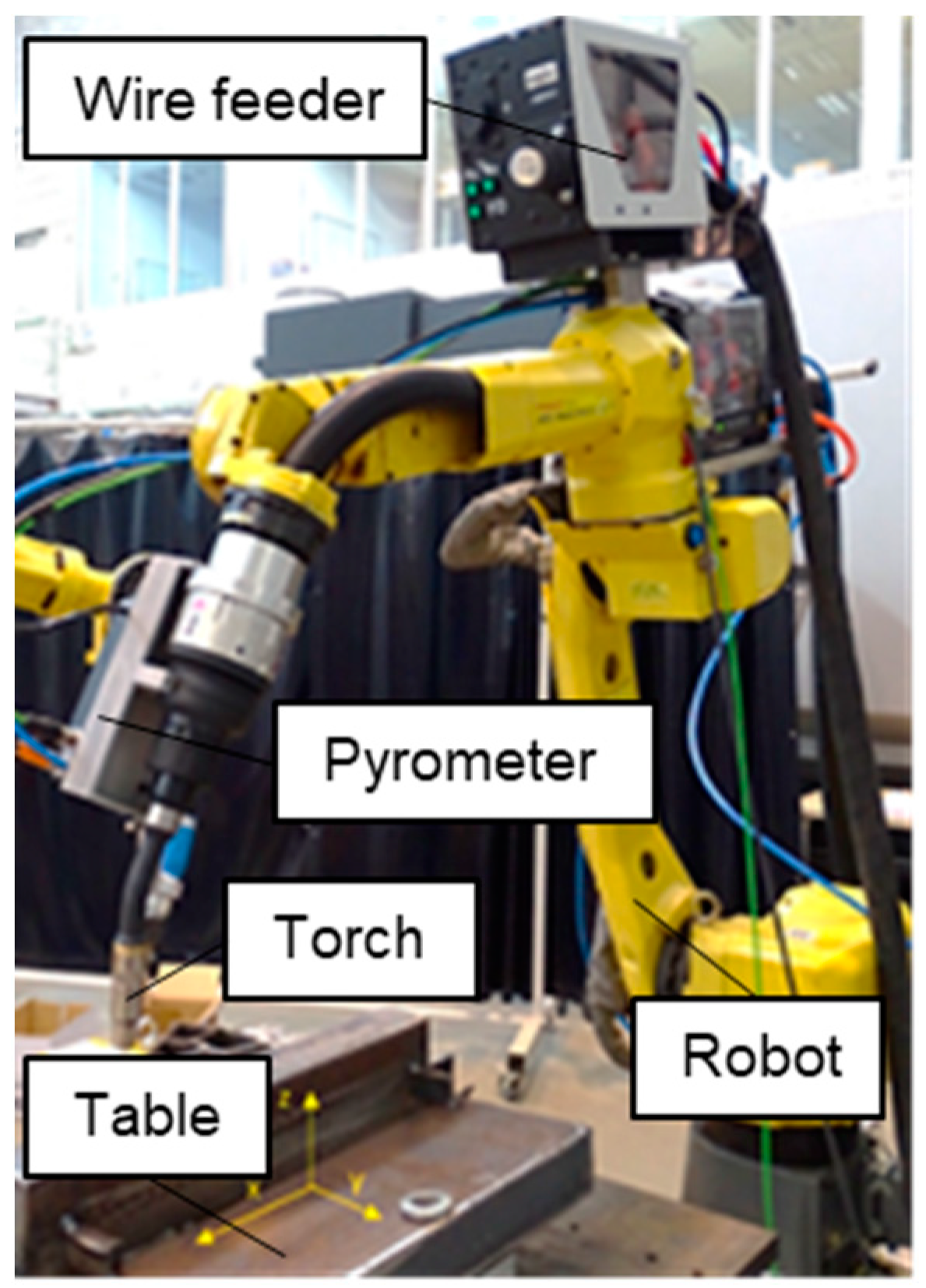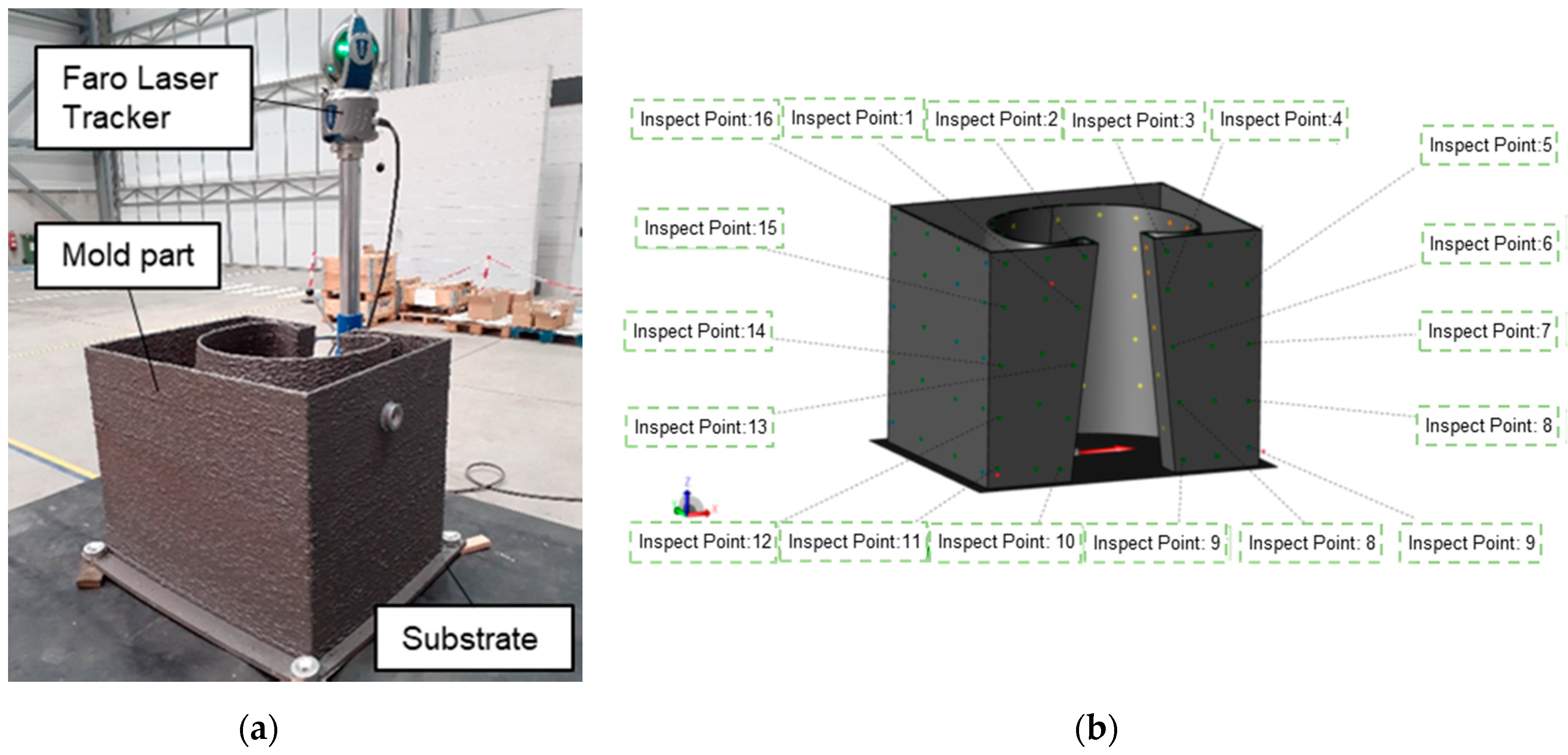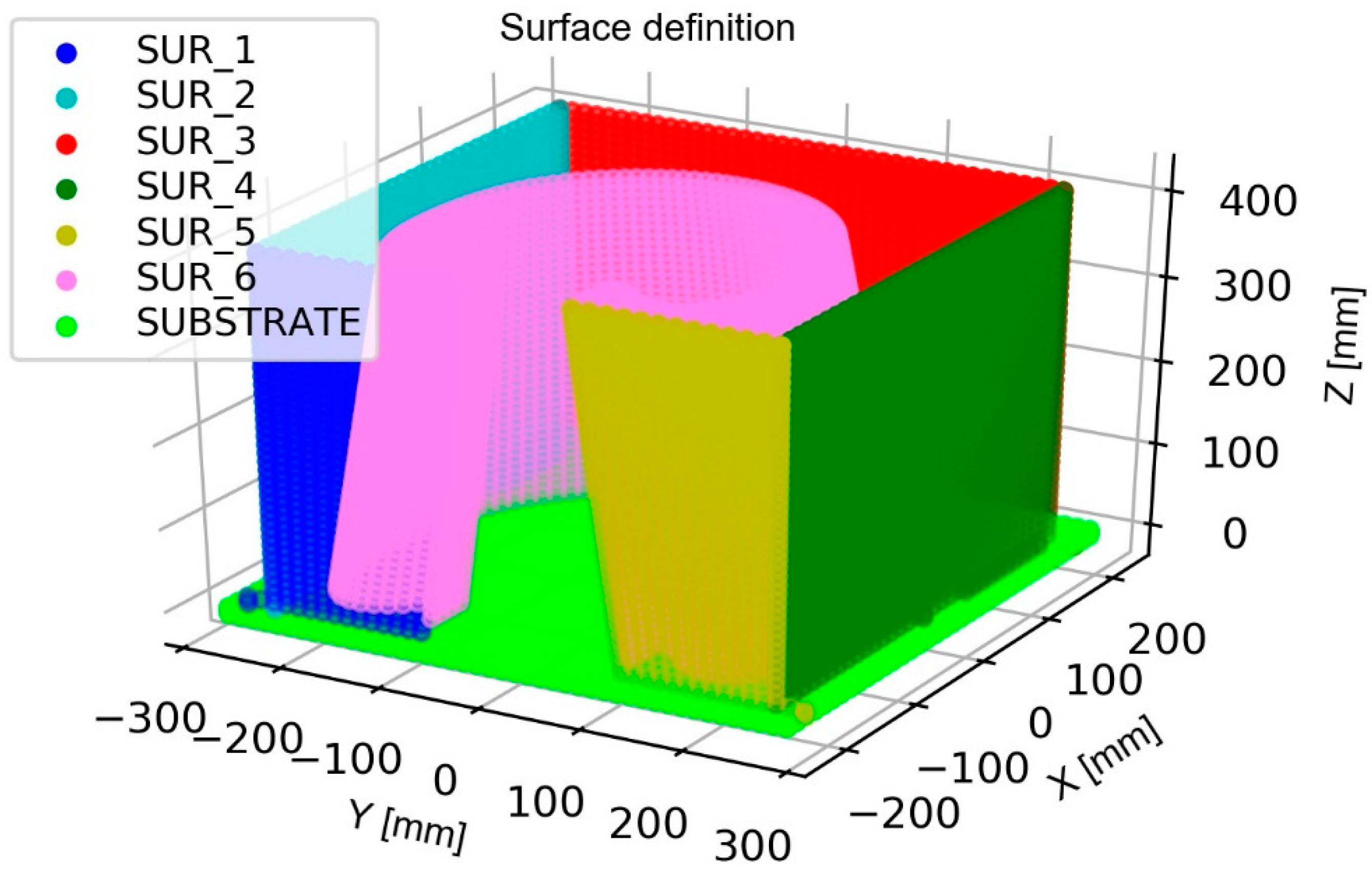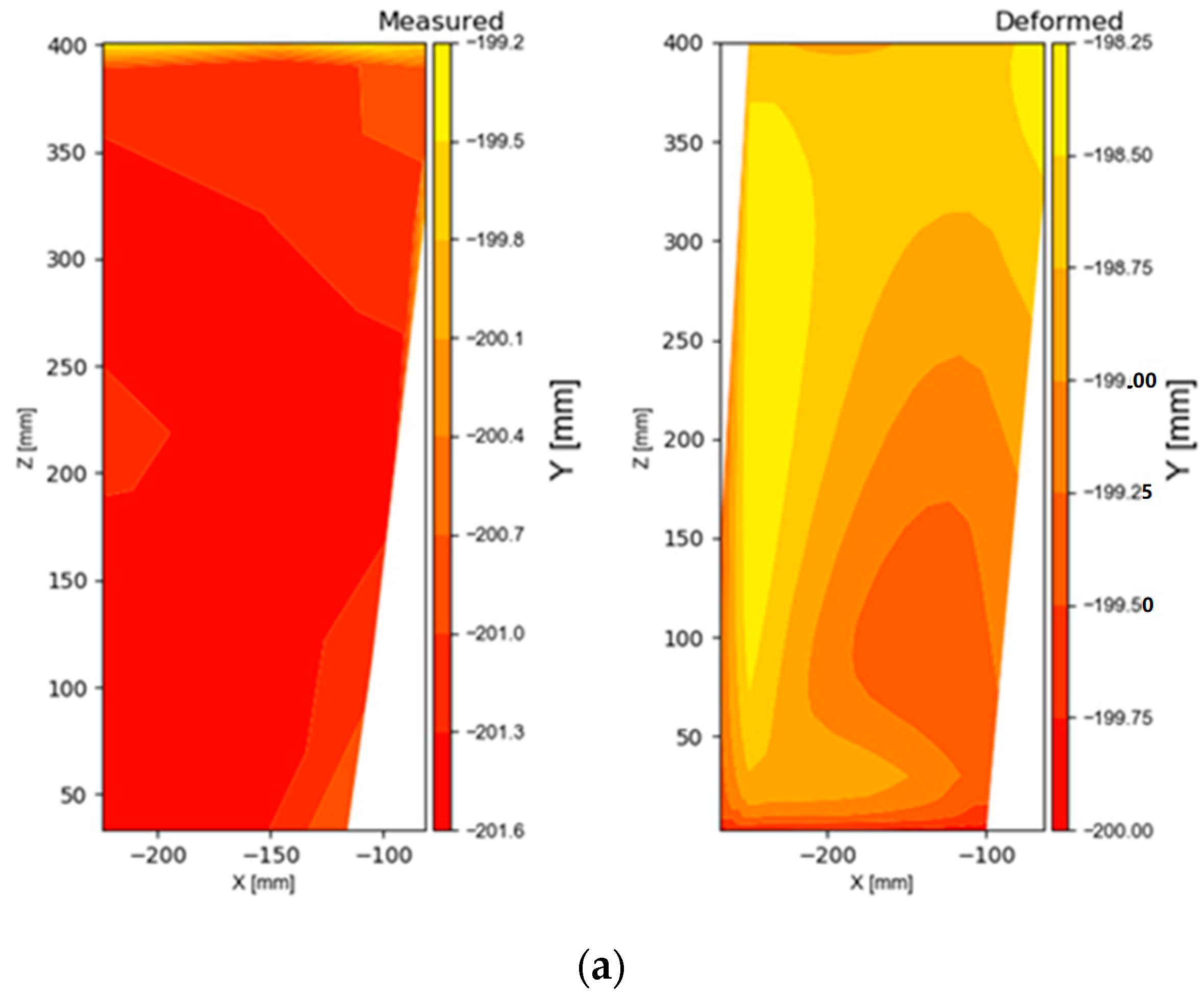Model for the Prediction of Deformations in the Manufacture of Thin-Walled Parts by Wire Arc Additive Manufacturing Technology
Abstract
1. Introduction
2. Materials and Methods
2.1. Set-Up for the Wire Arc Additive Manufacturing of the Part
2.2. Methodology for Material Characterization and Part Verification
3. Results
3.1. Mechanical Characterization of Additive Manufacturing Material
3.2. Model for the Simulation of Thin-Wall Deformations
3.3. Measurement of Final Part Deformation
4. Discussion
Comparison of the Results Predicted by the Model and the Final Part Measurements
5. Conclusions
- The methodology for the manufacture of a mold piece by means of GMAW-WAAM technology with the combination of two transfer methods Cold-Arc and pulsed-GMAW has been presented.
- The deposition conditions ensure good metallographic quality and mechanical properties like those given by the supplier of the wire material.
- The finite element model predicts the process temperature. The adjustment of the predicted values with the temperature measured by means of pyrometric techniques shows accurate fitting. Results show deviation of less than a 5% in the temperature prediction.
- The deformation prediction model allows to know qualitatively the deformation mode of the part. Qualitatively the results are correct but can be improved, due to the external sources of error described. The surface waviness of the part manufactured, which reaches 2 mm from peak to valley, is one of most important.
- Finally, this paper has covered the purpose of prospecting the application of finite element simulation models for the prediction of deformations in thin-walled parts manufactured by WAAM technology.
Author Contributions
Funding
Institutional Review Board Statement
Informed Consent Statement
Data Availability Statement
Acknowledgments
Conflicts of Interest
Nomenclature
| E | Energy |
| I | Intensity |
| V | Voltage |
| TS | Travel speed |
| UTS | Ultimate tensile strength |
| YS | Yield stress |
| qf | Power density distribution in the front half of the heat source |
| qr | Power density distribution in the rear half of the heat source |
| ff | Fraction of the heat deposited in the front half of the heat source |
| fr | Fraction of the heat deposited in the rear half of the heat source |
| cf | Forward length of the heat source along the length of the layers |
| cr | Rear length of the heat source along the length of the layers |
| a | Width of the heat source |
| b | Depth of the heat source |
| Q | Power of the heat source |
| η | Heat source efficiency |
| d(P1, P2) | Distance between two points |
| d(P, π) | Distance between a point and a plane |
References
- Teresa, A.; Suárez, A.; Veiga, F.; Braceras, I.; Tabernero, I.; Larrañaga, O.; Lamikiz, A. Wire arc additive manufacturing Ti6Al4V aeronautical parts using plasma arc welding: Analysis of heat-treatment processes in different atmospheres. J. Mater. Res. Technol. 2020, 9, 15454–15466. [Google Scholar]
- Cunningham, C.; Flynn, J.; Shokrani, A.; Dhokia, V.; Newman, S. Invited review article: Strategies and processes for high quality wire arc additive manufacturing. Addit. Manuf. 2018, 22, 672–686. [Google Scholar] [CrossRef]
- Rodrigues, T.A.; Duarte, V.; Miranda, R.M.; Santos, T.G.; Oliveira, J.P. Current status and perspectives on wire and arc additive manufacturing (WAAM). Materials 2019, 12, 1121. [Google Scholar] [CrossRef] [PubMed]
- Lu, X.; Lin, X.; Chiumenti, M.; Cervera, M.; Hu, Y.; Ji, X.; Ma, L.; Yang, H.; Huang, W. Residual stress and distortion of rectangular and S-shaped Ti-6Al-4V parts by directed energy deposition: Modelling and experimental calibration. Addit. Manuf. 2019, 26, 166–179. [Google Scholar] [CrossRef]
- Wu, B.; Pan, Z.; Ding, D.; Cuiuri, D.; Li, H.; Xu, J.; Norrish, J. A review of the wire arc additive manufacturing of metals: Properties, defects and quality improvement. J. Manuf. Process. 2018, 35, 127–139. [Google Scholar] [CrossRef]
- D’Alvise, L.; Chantzis, D.; Schoinochoritis, B.; Salonitis, K. Modelling of part distortion due to residual stresses relaxation: An aerOnautical case study. Procedia CIRP 2015, 31, 447–452. [Google Scholar] [CrossRef]
- Li, J.; Wang, S. Distortion caused by residual stresses in machining aeronautical aluminum alloy parts: Recent advances. Int. J. Adv. Manuf. Technol. 2017, 89, 997–1012. [Google Scholar] [CrossRef]
- Casuso, M.; Polvorosa, R.; Veiga, F.; Suárez, A.; Lamikiz, A. Residual stress and distortion modeling on aeronautical aluminum alloy parts for machining sequence optimization. Int. J. Adv. Manuf. Technol. 2020, 110, 1219–1232. [Google Scholar] [CrossRef]
- Tomaz, L.; Colaço, F.H.G.; Sarfraz, S.; Pimenov, D.Y. Investigations on quality characteristics in gas tungsten arc welding process using artificial neural network integrated with genetic algorithm. Int. J. Adv. Manuf. Technol. 2021, 113, 3569–3583. [Google Scholar] [CrossRef]
- Arora, H.; Kumar, V.; Prakash, C.; Pimenov, D.; Singh, M.; Vasudev, H.; Singh, V. Analysis of Sensitization in Austenitic Stainless Steel-Welded Joint. In Advances in Metrology and Measurement of Engineering Surfaces, Lecture Notes in Mechanical Engineering; Prakash, C., Krolczyk, G., Singh, S., Pramanik, A., Eds.; Springer: Singapore, 2021; pp. 13–24. [Google Scholar]
- Srivastava, S.; Garg, R.K.; Sharma, V.S.; Sachdeva, A. Measurement and mitigation of residual stress in wire-arc additive manufacturing: A review of macro-scale continuum modelling approach. Arch. Comput. Methods Eng. 2020, 1–25. [Google Scholar] [CrossRef]
- Ding, J.; Colegrove, P.; Mehnen, J.; Ganguly, S.; Almeida, P.S.; Wang, F.; Williams, S. Thermo-mechanical analysis of wire and arc additive layer manufacturing process on large multi-layer parts. Comput. Mater. Sci. 2011, 50, 3315–3322. [Google Scholar] [CrossRef]
- Ding, J.; Colegrove, P.; Mehnen, J.; Williams, S.; Wang, F.; Almeida, P.S. A computationally efficient finite element model of wire and arc additive manufacture. Int. J. Adv. Manuf. Technol. 2014, 70, 227–236. [Google Scholar] [CrossRef]
- Zhao, H.; Zhang, G.; Yin, Z.; Wu, L. Three-dimensional finite element analysis of thermal stress in single-pass multi-layer weld-based rapid prototyping. J. Mater. Process. Technol. 2012, 212, 276–285. [Google Scholar] [CrossRef]
- Cadiou, S.; Courtois, M.; Carin, M.; Berckmans, W.; Masson, P.L. Heat transfer, fluid flow and electromagnetic model of droplets generation and melt pool behaviour for wire arc additive manufacturing. Int. J. Heat Mass Transf. 2020, 148, 119102. [Google Scholar] [CrossRef]
- Osher, S.; Sethian, J.A. Fronts propagating with curvature-dependent speed: Algorithms based on Hamilton-Jacobi formulations. J. Comput. Phys. 1988, 79, 12–49. [Google Scholar] [CrossRef]
- Oyama, K.; Diplas, S.; M’Hamdi, M.; Gunnæs, A.E.; Azar, A.S. Heat source management in wire-arc additive manufacturing process for Al-Mg and Al-Si alloys. Addit. Manuf. 2019, 26, 180–192. [Google Scholar] [CrossRef]
- Rafieazad, M.; Ghaffari, M.; Nemani, A.V.; Nasiri, A. Microstructural evolution and mechanical properties of a low-carbon low-alloy steel produced by wire arc additive manufacturing. Int. J. Adv. Manuf. Technol. 2019, 105, 2121–2134. [Google Scholar] [CrossRef]
- Prado-Cerqueira, J.L.; Camacho, A.M.; Diéguez, J.L.; Rodríguez-Prieto, Á.; Aragón, A.M.; Lorenzo-Martín, C.; Yanguas-Gil, Á. Analysis of favorable process conditions for the manufacturing of thin-wall pieces of mild steel obtained by wire and arc additive manufacturing (WAAM). Materials 2018, 11, 1449. [Google Scholar] [CrossRef]
- Dttmann, A.; Gomes, J.D.O. Evaluation of additive manufacturing parts machinability using automated GMAW ER70S-6 with nodular cast iron. U. Porto J. Eng. 2021, 7, 88–97. [Google Scholar] [CrossRef]
- Wang, Q.; Qi, B.; Cong, B.; Yang, M. Output characteristic and arc length control of pulsed gas metal arc welding process. J. Manuf. Process. 2017, 29, 427–437. [Google Scholar] [CrossRef]
- Metallic materials—Tensile testing—Part 1: Method of test at room temperature. Met. Mater. 2020, 1–78, ISO 6892-1:2019. Available online: https://www.iso.org/standard/78322.html (accessed on 6 April 2021).
- Aldalur, E.; Veiga, F.; Suárez, A.; Bilbao, J.; Lamikiz, A. Analysis of the wall geometry with different strategies for high deposition wire arc additive manufacturing of mild steel. Metals 2020, 10, 892. [Google Scholar] [CrossRef]
- Aldalur, E.; Veiga, F.; Suárez, A.; Bilbao, J.; Lamikiz, A. High deposition wire arc additive manufacturing of mild steel: Strategies and heat input effect on microstructure and mechanical properties. J. Manuf. Process. 2020, 58, 615–626. [Google Scholar] [CrossRef]
- Zhang, H.; Zhang, G.; Cai, C.; Gao, H.; Wu, L. Fundamental studies on in process controlling angular distortion in asym-metrical double-sided double arc welding. J. Mater. Process. Technol. 2008, 205, 214–223. [Google Scholar] [CrossRef]
- MSC Mentat Marc. MARC User Guide; Version 2010; MSC Software Corporation: Santa Ana, CA, USA, 2010. [Google Scholar]
- Goldak, J.; Chakravarti, A.; Bibby, M. A new finite element model for welding heat sources. Met. Mater. Trans. A 1984, 15, 299–305. [Google Scholar] [CrossRef]
- Ferro, P.; Berto, F.; James, N. Asymptotic residual stress distribution induced by multipass welding processes. Int. J. Fatigue 2017, 101, 421–429. [Google Scholar] [CrossRef]
- Graf, M.; Pradjadhiana, K.P.; Hälsig, A.; Manurung, Y.H.P.; Awiszus, B. Numerical simulation of metallic wire arc additive manufacturing (WAAM). AIP Conf. Proc. 2018, 1960, 140010. [Google Scholar] [CrossRef]
- Abid, M.; Siddique, M. Numerical simulation to study the effect of tack welds and root gap on welding deformations and residual stresses of a pipe-flange joint. Int. J. Press. Vessel. Pip. 2005, 82, 860–871. [Google Scholar] [CrossRef]













| Mn | Si | C | Cr | Cu | Ni | S | P | Mo | Ti | Zr |
|---|---|---|---|---|---|---|---|---|---|---|
| 1.64 | 0.94 | 0.06 | 0.02 | 0.02 | 0.02 | 0.016 | 0.013 | 0.005 | 0.004 | 0.002 |
| Program Number | Material | Density (kg/m3) | Material Sustrate | Wire Diameter (mm) | Mode | Job Number | Wire Feed (m/min) | Deposition Rate (kg/h) | Stick Out (mm) | Travel Speed (cm/min) | Bead Width (mm) | Stimated Height (mm) |
|---|---|---|---|---|---|---|---|---|---|---|---|---|
| N# 1 | ER70S-6 | 7850 | S235JR | 1.2 | Cold Arc | 194 | 5 | 2.66 | 17 | 50 | 7.2 | 1.6 |
| N# 2 | ER70S-6 | 7850 | S235JR | 1.2 | Pulsed-GMAW | 9 | 5 | 2.66 | 17 | 50 | 7.2 | 1.6 |
| N# 3 | ER70S-6 | 7850 | S235JR | 1.2 | Pulsed-GMAW | 9 | 5 | 2.66 | 17 | 65 | 7.2 | 1.3 |
| Material | Direction | Tensile Test | Vickers Test | ||
|---|---|---|---|---|---|
| UTS (MPa) | YS 0.2% (MPa) | Elong. (%) | Hardness [HV] | ||
| WAAM sample wall | Horizontal | 498 ± 9 | 368 ± 12 | 36 ± 4 | 151 ± 9 |
| Vertical | 501 ± 3 | 368 ± 4 | 32 ± 1 | ||
| ER70 as welded | - | 500–640 | >420 | 28 | |
Publisher’s Note: MDPI stays neutral with regard to jurisdictional claims in published maps and institutional affiliations. |
© 2021 by the authors. Licensee MDPI, Basel, Switzerland. This article is an open access article distributed under the terms and conditions of the Creative Commons Attribution (CC BY) license (https://creativecommons.org/licenses/by/4.0/).
Share and Cite
Casuso, M.; Veiga, F.; Suárez, A.; Bhujangrao, T.; Aldalur, E.; Artaza, T.; Amondarain, J.; Lamikiz, A. Model for the Prediction of Deformations in the Manufacture of Thin-Walled Parts by Wire Arc Additive Manufacturing Technology. Metals 2021, 11, 678. https://doi.org/10.3390/met11050678
Casuso M, Veiga F, Suárez A, Bhujangrao T, Aldalur E, Artaza T, Amondarain J, Lamikiz A. Model for the Prediction of Deformations in the Manufacture of Thin-Walled Parts by Wire Arc Additive Manufacturing Technology. Metals. 2021; 11(5):678. https://doi.org/10.3390/met11050678
Chicago/Turabian StyleCasuso, Mikel, Fernando Veiga, Alfredo Suárez, Trunal Bhujangrao, Eider Aldalur, Teresa Artaza, Jaime Amondarain, and Aitzol Lamikiz. 2021. "Model for the Prediction of Deformations in the Manufacture of Thin-Walled Parts by Wire Arc Additive Manufacturing Technology" Metals 11, no. 5: 678. https://doi.org/10.3390/met11050678
APA StyleCasuso, M., Veiga, F., Suárez, A., Bhujangrao, T., Aldalur, E., Artaza, T., Amondarain, J., & Lamikiz, A. (2021). Model for the Prediction of Deformations in the Manufacture of Thin-Walled Parts by Wire Arc Additive Manufacturing Technology. Metals, 11(5), 678. https://doi.org/10.3390/met11050678










